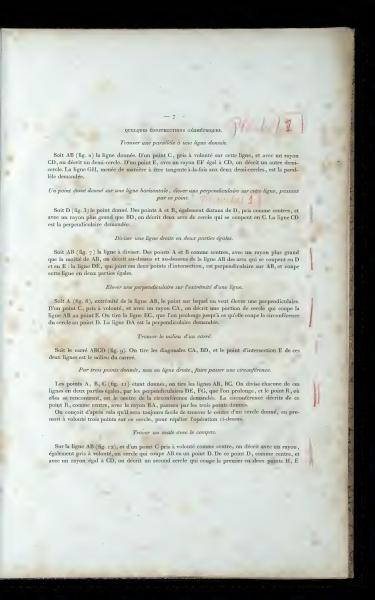The text provides methods for basic geometric constructions, such as finding parallel and perpendicular lines, dividing lines into equal parts, finding the center of a square, and constructing circles through given points. Instructions include using arcs and lines to achieve these constructions. Additionally, it describes how to draw an oval using a compass.
Some Geometric Constructions.
Finding a parallel to a given line.
Let AB (fig. 2) be the given line. From a point C, taken at will on this line, and with a radius CD, a semicircle is described. From a point E, with a radius EF equal to CD, another semicircle is described. The line GH, drawn in such a way as to be tangent to both semicircles, is the required parallel.
A point given on a horizontal line, erect a perpendicular on this line, passing through this point.
Let D (fig. 3) be the given point. From points A and B, equally distant from D, taken as centers, and with a radius larger than BD, two arcs are drawn that intersect at C. The line CD is the required perpendicular.
Dividing a straight line into two equal parts.
Let AB (fig. 7) be the line to be divided. From points A and B as centers, with a radius larger than half of AB, arcs are drawn above and below the line AB that intersect at points D and E: the line DE, joining these two points of intersection, is perpendicular to AB and divides this line into two equal parts.
Erecting a perpendicular at the end of a line.
Let A (fig. 8) be the end of the line AB, the point where we want to erect a perpendicular. From a point C, chosen at will, and with a radius CA, an arc is drawn that cuts the line AB at point D. The line EC, extended until it intersects the arc at point P, makes the line DA the perpendicular needed.
Finding the center of a square.
Let ABCD (fig. 9) be the square. Draw the diagonals CA, BD, and the intersection point E of these two lines is the center of the square.
Through three given points, not on a straight line, draw a circle.
Given points A, B, C (fig. 11), draw lines AB, BC. Each of these lines is bisected by perpendiculars DE, FG, extended until they intersect at point R, which is the center of the required circle. The circle described from this center R, with radius RA, will pass through the three given points. It follows that it will always be easy to find the center of a given circle by selecting any three points on this circle to repeat the above operation.
Draw an oval with the compass.
On line AB (fig. 12), and from a point C taken randomly as the center, a circle with a chosen radius is described, which intersects AB at point D. From this point D, as the center, and with a radius equal to CD, a second circle is drawn that intersects the first at points H and E.
